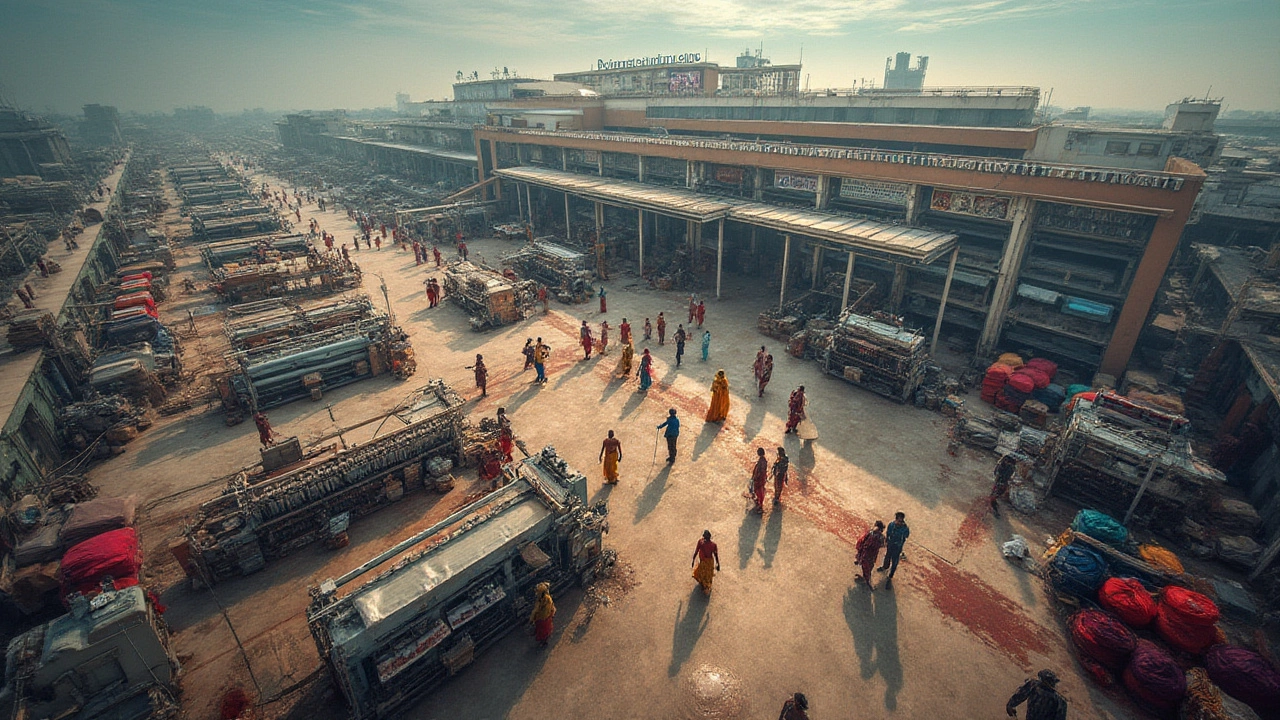It might surprise people outside the industry just how huge India’s textile sector is. It’s not just about sarees, kurtas, or the cotton you see in markets; we’re talking nearly 5% of India’s GDP and the second biggest employer after agriculture. With thousands of players, picking the top dog isn’t a casual game—it comes down to market share, capacity, global reach, and the hard numbers on the balance sheet. But peel back the layers, and amid names like Arvind, Vardhman, Grasim, Welspun, and Raymond, one Goliath consistently dwarfs its peers: Reliance Industries Limited (RIL).
Why Reliance Industries Dominates India’s Textile Scene
Reliance isn’t just big in oil, telecom, and retail. In textiles, it’s quietly, steadily outpaced the pack, starting with its roots in polyester and now stretching to almost every corner of the industry. When you find polyester threads running through Indian-made clothes—casual shirts in Delhi, sportwear in Manchester, bedsheets in hotels from Singapore to Berlin—chances are decent that the molecule started life in a Reliance plant.
Polyester is king in India, making up more than 60% of all fibers produced here, and Reliance is the undisputed leader in polyester production. It controls nearly two-thirds of India’s polyester capacity and is one of the top five global producers. Just pause on that: one company, making the feedstock for billions of garments each year. In FY 2024, Reliance produced over 2.5 million tons of polyester fiber and yarn—enough to make over 12 billion T-shirts annually. When industry experts discuss the consolidation and modernization of India’s textile sector, they're really talking about the influence of Reliance.
There’s another side: vertical integration. Most clothing brands depend on dozens of suppliers from spinning fibers, weaving, dyeing, finishing—each step increases cost, complexity, risk of delays. Reliance owns virtually every part of the polyester value chain—from cracker plants that refine oil into chemicals, all the way to textured yarns striped in markets across the world. That brings costs down, efficiency up, and gives them unmatched muscle in pricing.
But what about natural fibers? Sure, Reliance may seem like a synthetic specialist, but it’s also moved into blended textiles which mix cotton, viscose, and even specialty fibers. As market tastes shift—especially with sustainability and eco-textiles becoming hot sellers—Reliance has launched new lines like Recron GreenGold, which offer recycled polyester certified by Global Recycled Standard (GRS). There’s a push into R&D too: the group invests more than ₹100 crores every year into polymers and textiles innovation, inventing lighter, stronger, more versatile fabrics that end up everywhere from high-street brands to home décor giants.
| Metric | Reliance Industries | No. 2 (Arvind Ltd) | No. 3 (Vardhman) |
|---|---|---|---|
| FY 2024 Textile Revenue (₹ Crore) | 27,800 | 8,600 | 7,900 |
| Polyester Capacity (Million Tons) | 2.5 | 0.15 | 0.09 |
| Global Presence (Countries Exported To) | 100+ | 40+ | 35+ |
| Employees in Textile Division | 27,000+ | 29,000+ | 23,000+ |
Take their export map. From Manchester to Marrakesh, you’ll find Reliance polyester. European sportswear giants, Asian home furnishing brands, even global fast fashion—these all buy yarn or fabric from a Reliance plant somewhere in India. Their sheer scale means Reliance ships to over 100 countries, putting "Made in India" labels in shopping bags from New York to Nairobi.
Let’s not ignore jobs either. With over 27,000 people working just in the textile division (not counting contract and support staff), Reliance is a cornerstone of families and communities from Gujarat to Maharashtra.
A lot of this isn’t just about size for the sake of it—there’s an engine of continuous reinvestment. Every major Indian textile cluster (Surat, Silvassa, Hazira) has seen Reliance put fresh money into technology, sustainability, and expansion. When companies like Arvind or Vardhman open new lines, they try to catch up with Reliance’s scale and integrated model.

How Reliance Sets the Standards for Quality, Innovation, and Sustainability
You’d think a gigantic company would be slow to change. But Reliance’s textile game is all about staying ahead—think quality, think new designs, think green initiatives. A few standout moves show why they’re still the No 1 textile company in India after so many waves of change.
First, they get that Indian and global buyers have zero patience for quality issues. Their plants use automated, AI-driven quality checks. Ever wondered why international sportswear brands happily source from India even after tough EU and US safety standards? A lot of that comes from Reliance’s strict protocols—tracking yarn diameter to the micron, color-fastness to the nth grade. Their internal rejection rate for fabric is less than 0.6%, far better than most industry averages, which float around 2-3%.
One practical tip if you’re running a textile enterprise yourself: borrow a page from Reliance and put quality at the front. Many Indian mills lose export orders for something as small as uneven dyeing or lint residue—things that can be solved by investing in basic automated inspection tools. Even a small fabric unit in Erode or Ludhiana that spends on quality assurance sees fewer returns and higher repeat business.
Next, look at product variety. Reliance operates like a dozen companies squeezed into one. Need flame-retardant yarns for uniforms? They’ve got it. Want antimicrobial polyester for hospitals? It’s already in their catalogue. They have entire business development teams that talk to international furniture chains, car seat makers, and even high-fashion brands in Korea, developing blends that never existed in the country a decade ago.
Then there’s the green side. For an industry infamous for its water and chemical use, Reliance has invested not just in compliance but real, measurable sustainability. Their GreenGold polyester uses recycled PET bottles—over 2.2 billion bottles diverted from landfills in 2024 alone, a number that’s double what it was just six years ago. They run one of Asia’s largest Zero Liquid Discharge plants, which makes sure that no textile wastewater leaves the site untreated.
Reliance also publishes annual sustainability reports—no hiding behind big claims. They lay out water saved (over 40 million cubic meters last year), energy reduced, toxic chemicals phased out, and new R&D projects focused on biodegradable fibers. Anyone running a textile business or sourcing manager for a big retailer will see Reliance has data to back every green badge on a product.
Innovation goes beyond eco-labels. Their R&D teams work with international design houses on textures, printing techniques, and “performance fibers” that wick away sweat, block UV rays, or resist stains. This focus on innovation opens up premium export markets, with Reliance fabrics now running in the uniforms of global aviation fleets, five-star hotel bedding, and even technical clothing for winter sports.
Tips for textile entrepreneurs: If you want to compete with Reliance, don’t just chase volume. Specialize—maybe develop one standout product, like quick-drying bedsheets or anti-pollution scarves, then market it hard. Use certifications like OEKO-TEX, GRS, or ISO as a way to signal extra value to customers. That’s how small firms can carve out a niche even as industry giants keep expanding.

The Future of India’s Textile Titans and the Lesson for New Entrants
Reliance isn’t slowing down. While Arvind continues making waves in denim and Raymond reinvents branded suiting, Reliance is pumping billions into high-tech polyester, digital supply chains, and ambitious green targets. They’re aiming to raise their recycled polyester share to 40% by 2030, and several factories are moving towards 100% renewable energy in their energy mix.
There are whispers of Reliance entering “next-gen fibers”—think bio-based polyesters, which use plant starch instead of oil. The company has started pilot programs in partnership with global biotech firms from Germany and the US. Imagine polyester with the comfort of cotton, sourced partly from sugarcane or agricultural waste, and entirely recyclable. The technology isn’t future talk; lab trials are ongoing, and sample lots are being tested by major American clothing brands.
For startups and younger companies, the message is clear: you don’t need to match Reliance’s scale, but you’ve got to find your angle. Maybe that means hyper-local handlooms, super-niche luxury blends, or digital-first custom tailoring. Pick a pain point—speed, sustainability, style, story—and offer something Reliance can’t (or won’t) deliver quickly.
Invest in skills. While Reliance brings technical training for operators and managers, small and midsize mills should send teams to workshops—think sustainable dyeing or digital printing. Tie up with engineering colleges. Take up government subsidy schemes for textile tech upgrades, especially with India’s new PLI (Production Linked Incentive) scheme for technical textiles.
If you want a hard benchmark, track Reliance’s performance numbers. In 2024, they delivered record high EBITDA margins (17% in textiles)—far above most sector averages. They draw international headline orders for new-age polyester, and their digital platform lets big retailers order, track, and customize shipments in real time. That’s the level today’s customers expect.
The textile industry will always have space for artisans, disruptors, and smaller specialists, but when you ask who leads, nobody else matches Reliance’s dominant grasp on capacity, innovation, and vision. They built a textile empire in a country of 1.4 billion, and they’re still shaping what “Indian textiles” mean to global buyers.
What makes India’s No 1 textile company so dominant isn’t just size. It’s the mix of scale, integration, R&D, and a ruthless push to set the trend rather than just follow it. For anyone in the textile business, watching how Reliance keeps their crown is like a masterclass—sometimes brutal, always worth studying.
